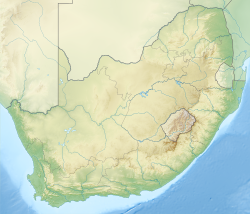The 1967 and 1969 excavations uncovered numerous artefacts that can be sorted in many ways, but are often sorted based on material, with lithics being considered separately from artefacts made from materials other than stone.
Lithics
The stone artefacts found at Melkhoutboom are used as the basis for sorting all of the artefacts in the Melkhoutboom sequence into three different artefact industries based on the typology of their lithics: the Wilton Industry, found in the Wilton Base Marker and overlying units; the Albany Industry, found in the Medium Brown Series and Rockfall units; and the Robberg Industry, found in the Basal unit. [3] These industries were based on terminology already adopted by archaeologists in the Eastern Cape region.
The Wilton Industry is primarily characterised by microliths and hafted tools, often made from chalcedony or silcrete. The two earlier industries are primarily composed of quartzite flakes and are therefore easily distinguished from the later Wilton Industry. [3]
Lithics belonging to the Wilton Industry can be further sorted into classes based on their form and function. Among the types of stone tools found at Melkhoutboom were chunks, chips, cores, core reduced pieces, battered pieces and debitage, unmodified flakes, retouched and modified flakes, scrapers, segments, backed bladelets, borers, adzes, anvils, hammerstones, grindstones, milled edge pebbles, and other broken or miscellaneous pieces. [3]
Besides stone tools, other stone artefacts found at Melkhoutboom included red and yellow ochre, pieces of shale and micaceous sandstone (which are not found naturally in or near the cave and were therefore likely imports into the site), and unmodified slabs of quartzite and quartzitic sandstone, some associated with hearths. [3]
Other artefacts
artefacts in a variety of materials were found at Melkhoutboom and, like lithics, they have been analysed as evidence of the activities that may have taken place at the site. These non-lithic artefacts were analysed in conjunction with lithic material, since stone tools are often used to manufacture or modify artefacts made from other materials.
Wooden artefacts found at the site included fire sticks, which are well-known ethnographically in the Eastern Cape and have been found at other Eastern Cape sites; fire drill bits; pegs, possibly used as hangers as evidenced by the pegs found in the walls by Hewitt in 1930, or possibly used for staking down skins for leatherworking; points, which were found in a range of sizes and shapes with no apparent single function; two possible handles for hafting stone tools, based on areas stained with dark resin; and other wooden artefacts that were broken or incomplete or whose function could not be determined. [3] The wooden artefacts in the Melkhoutboom sequence are comparable to those from Gwisho sites in Zambia, dating to 4000 BP, as well as to those made by present-day Bushmen of the Kalahari Desert. [3]
In addition to standard wood artefacts, many cut lengths of reed were recovered from the higher sequences. These are thought to have played an important role in making the composite tools characteristic of the Wilton Industry, and some may also have been used as arrow shafts. [3]
Several pieces of cord made from plant material were also found, along with a few small pieces of netting made from the same type of cord. The netting appears too fine to have been used for hunting and fishing, and is thought to have been used to transport plant waste; this interpretation is supported by ethnography, and by the fact that the netting was found in association with plant waste. [3]
Shell artefacts and fragments were found in almost every unit of the site, and were well preserved except in the very lowest units. Most of the shell pieces found were fragments, but decoration could be seen on some of the ostrich eggshell pieces, and unidentified marine shells were used to make the beads found in one of the burials. All of the marine shell found, including those from sea snails (found in all except the Basal unit, which corresponds to the late Pleistocene and lower sea level) and clams (found in much lower frequency), was imported to the site, likely for ornamental use. Ostrich eggshell and land snail shell fragments were found throughout all levels, and freshwater mussel shells were found in upper levels. [3]
Compared to the numbers of wood and shell artefacts, there were far fewer bone artefacts found. Only a single ornamental item made of bone was found – a lynx vertebra with holes drilled in it, possibly for cord to be strung through, and colouration from red ochre. The rest of the bone artefacts found were tools: one spatula-like tool, four pointed tools, and a few small flakes of bone. [3]
A small amount of pottery was found on the surface level, as well as a few small deposits in some of the pits that were discovered. The few rim sherds that were found appear to have come from pots and bowls. On the few decorated pieces found, the decoration consisted of simple dotting or incisions, comparable to pottery found at Scott's Cave and in some of the coastal middens. [3]
Additionally, a few leather artefacts were found in the main bedding. Only one fully reconstructible garment was found: a pull-through made of grysbok (antelope) leather, similar to those worn by present-day hunter-gatherer groups in South Africa. The remaining leather artefacts were small pieces of skin, some sewn, mostly from small antelope. [3]


